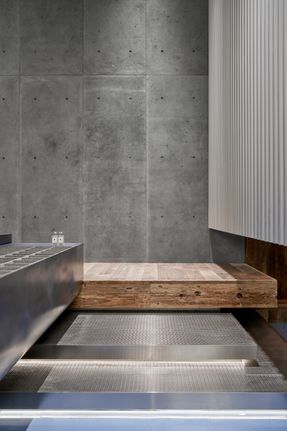Harmay Guangzhou
ARCHITECTS
Nihilii Studio
DISPLAY SUPPLIER
Shanghai Yueben Decoration Engineering Co., Ltd.
LEAD ARCHITECT
Fuzi He
DESIGN TEAM
Mengjie Li, Jiayao Wang, Ouyang Zijie, Yang Yang
LIGHTING DESIGN
上海莱米达照明设计工程有限公司
GENERAL CONTRACTOR
Beijing Baishangda Decoration Design Engineering Co., Ltd.
RENDERINGS
上海百力效果图工作室
TEXT
Yanyun Hu
CLIENT
Harmay
PHOTOGRAPHS
Bowen Gu
AREA
749 M²
YEAR
2022
LOCATION
Guangzhou, China
CATEGORY
Store
Situated in Guangzhou, a historic port city in southern China, our completed interior design project draws inspiration from the city's maritime heritage and cultural significance.
The concept takes cues from the city's role as a trading hub and the starting point of the maritime Silk Road.
The space is divided into two levels, with the ground floor accessed from the street. The main entrance features a perforated stainless steel grille and aluminum panels on the walls and ceilings, creating a visually striking composition.
The material transitions guide visitors through the space, while a wave-shaped aluminum sheet acts as both a visual barrier and a guide.
Upon entering the interior, a sense of tranquility and openness is experienced. An elevated wooden platform offers a panoramic view of the entire space, while a blue staircase becomes the visual centerpiece, evoking a seaside atmosphere.
The ground floor features aluminum frames, glass curtain walls, and concrete columns, reminiscent of a dockyard. Red steel columns with mechanical hooks create a visual resemblance to port cranes.
The design concept employs a montage technique, combining scenes related to sea, shipping, and port.
Different perspectives and associations are created as viewers' gazes shift, triggering a narrative and flashback effect. Props such as furniture, display stands, and partitions are strategically placed, emphasizing core elements and creating a dynamic visual experience.
The props also serve functional purposes, guiding circulation, dividing areas, and displaying products.
Through color, texture, and form, the design aims to stimulate viewers' imagination and create a rhythmic transition between scenes.
The composition of the space reflects the historical and cultural context of Guangzhou, inviting visitors to explore and engage with the maritime narrative.































